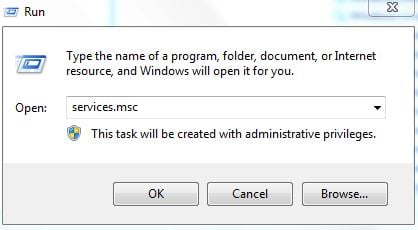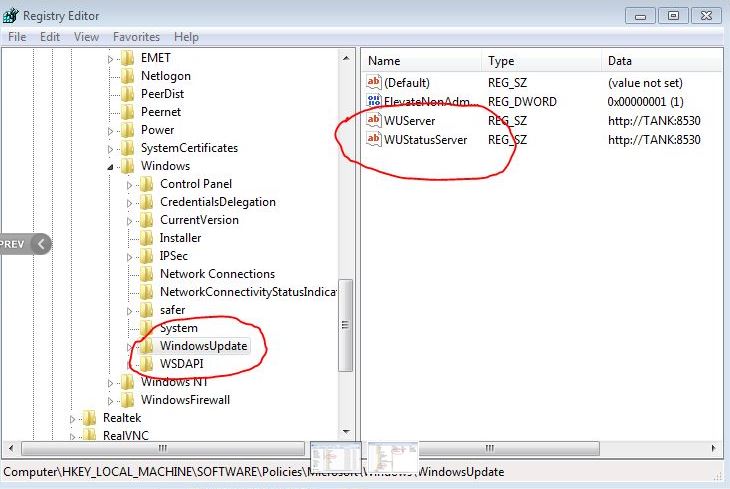Fix: Windows Update Error 80072ee2
Error 80072ee2 is a Windows update error, which occurs when the files on your system are corrupt or the updates are stuck. The fix described in this method also applies to errors 8024400A and 8024400D.
Before you proceed with the fix below, ensure that your internet is working on the PC affected by this error. This is because it will need to connect to the Windows update servers to push updates back.
Solutions for Fixing Windows Update Error 80072ee2.
Solution 1: Editing the Registry.
The best working fix for this update error is changing the registry and deleting some keys. It should be mentioned beforehand that not all users may have the registry key in their computers because they are using Windows in a home-based environment (not part of any domain). This primarily signifies that home users will not have the key.
- Hold the Windows key and press R
- In the Run dialog that opens up, type “services.msc” and click “OK.

- In the Services console, locate the service called “Windows Update“. Right-click this service and select Stop.
- We need to stop the ‘Windows Update’ service, which is responsible for updating Windows, before we make changes to fix the corruption. If you continue without stopping it, this will result in an error.

- Now, hold the Windows key and press R again.
- In the run dialog, type:
C:\Windows\SoftwareDistribution
- Click OK.
- Delete the contents of this folder.
- Now, return to the Services Console. Right-click the Windows Update service again and select ‘Start‘.
- Hold the Windows key and press R again.
- Type “regedit” in the Run dialog.
- In the Registry Editor, browse to the following path:
HKEY_LOCAL_MACHINE\SOFTWARE\Policies\Microsoft\Windows\WindowsUpdate

- In the right pane, look for the keys called WUServer and WUStatusServer.
- Right click on each of these keys and select Delete.
- Now, return to the Services console and make sure the Windows Update service is still running.
- Once finished, you should be able to update without errors.
Solution 2: Run the Windows Update Troubleshooter.
The Windows Update Troubleshooter checks all the settings and registries of your computer, compares them to the requirements of Windows Update, and then suggests possible changes to fix the issue. Ensure you have an administrator account before running the troubleshooter.
- Press Windows + S to launch the Start menu’s search bar. Type “troubleshoot” in the dialogue box, and click on the first result that appears.

- Once in the troubleshoot menu, select “Windows Update” and click the “Run the troubleshooter” button. If you are using Windows 7, you can navigate to the troubleshooter manually using the Control Panel.

- Now, Windows will begin the troubleshooting process and look for any discrepancies. You may be prompted that the troubleshooter requires administrator access to check for problems with your system. Click the option ‘Try troubleshooting as an administrator.’

- After the fixes are implemented, restart your computer and check if the problem has been resolved.

Note: This solution requires an active internet connection for optimal results. Also, try running the troubleshooter multiple times instead of attempting it only once.
Solution 3: Deleting the Software Distribution.
SoftwareDistribution is a folder located in the Windows directory, which is used to temporarily store files that may be required for installing the latest Windows updates on your computer. This is a requirement for the update module, and the read/write operations regarding this folder are managed by WUAgent.
Note: This method will also clear all your update history.
- Press Windows + S, type “command prompt” in the dialogue box, right-click on the application, and select “Run as administrator.
- In the command prompt, type the following commands one at a time:
net stop cryptSvc net stop wuauserv net stop msiserver net stop bits

Now, we will navigate to the Windows Update directory and delete all the existing updated files. Open your File Explorer or My Computer and follow the steps.
- Navigate to the address written below. You can also launch the Run application and copy-paste the address to reach it directly.
C:\Windows\SoftwareDistribution
- Delete everything inside the Software Distribution folder (you can also cut and paste the contents to another location in case you want to restore them later).

Note: You can also choose to rename the software distribution folder. Name it something like “SoftwareDistributionOld.
Now, we have to turn the Windows Update service back on and launch it again. Initially, the Update Manager may take a few minutes to compute details and prepare a manifest for the download.
- Open an elevated command prompt and try executing the following commands to reinitialize all the services that were stopped.
net start cryptSvc net start wuauserv net start msiserver net start bits

- Now restart your computer and try updating Windows again.
Note: You can also try running the following commands in order, in the elevated command prompt.
net stop wuauserv rmdir /q /s c:\windows\softwaredistribution\. wuauclt /detectnow
If the problem is related to your network settings, executing the following command in an elevated command prompt will fix the issue.
netsh int tcp set global autotuninglevel=disabled
Solution 4: Checking Official Microsoft documentation
In some cases, if you are running a Windows server, you should check Microsoft’s official documentation and see if this case applies to you. It seems that some updates have been superseded by further updates for the operating system.
This issue is quite common, so Windows has officially released documentation that shows how it can be fixed. Go through the steps provided, apply all the fixes, and then restart your computer completely.
Solution 5: Completely Resetting Windows Update Modules.
If all the above methods don’t work for you, you can try resetting all the Windows update modules forcefully and then try launching them again through a restart. The error message under discussion is very widespread and surfaced after a blunder by Microsoft itself when it changed the validity date at the server side in the main update XML file. Since editing the XML file would void the digital signature at our side, Microsoft changed the XML at their end but the error still persists. Maybe reinitializing all the modules will fix the problem for us.
- Press Windows + S, type “command prompt,” right-click on the application, and select “Run as administrator.
- Once in the elevated command prompt, execute the following commands one by one.
net stop wuauserv cd %systemroot% ren SoftwareDistribution SoftwareDistribution.old net start wuauserv net stop bits net start bits net stop cryptsvc cd %systemroot%\system32 ren catroot2 catroot2.old net start cryptsvc regsvr32 Softpub.dll /s regsvr32 Wintrust.dll /s regsvr32 Initpki.dll /s regsvr32 Mssip32.dll /s
- After executing all the commands, restart your computer completely, and check if the problem is resolved.